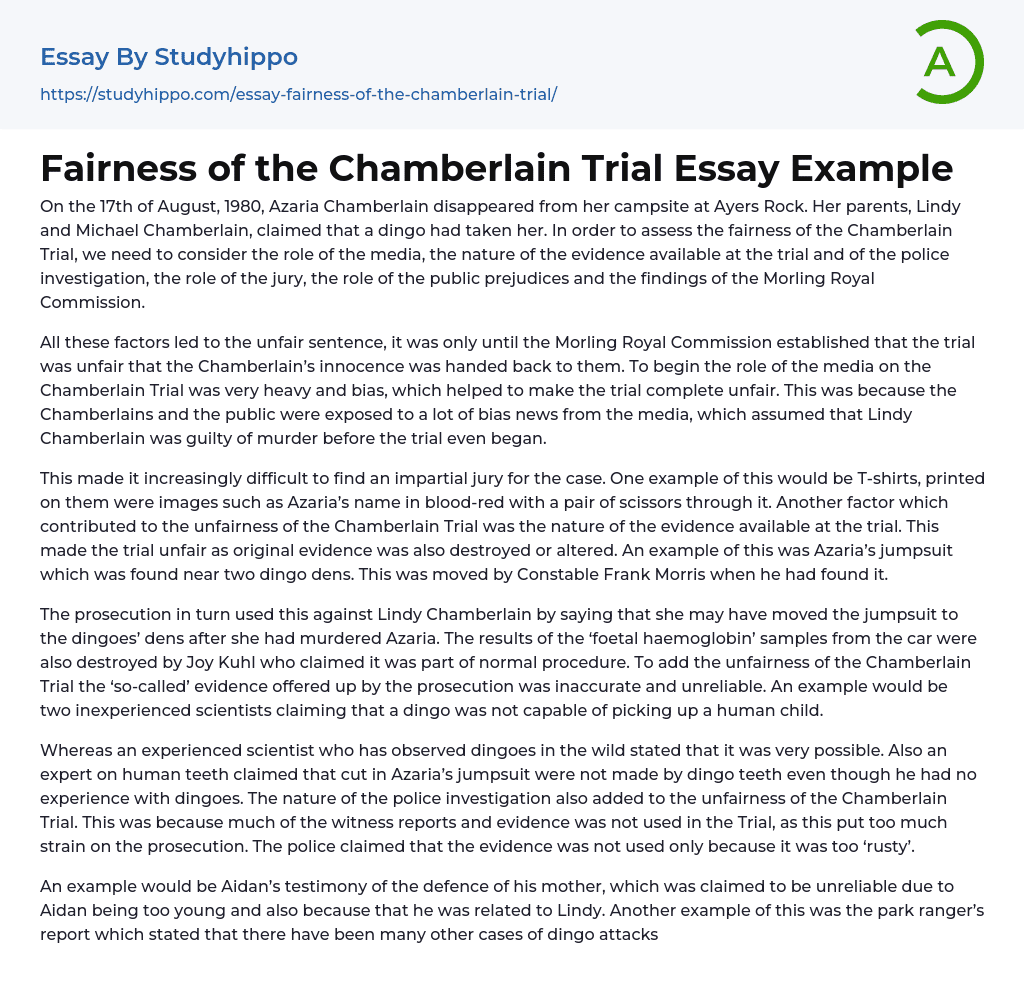On the 17th of August, 1980, Azaria Chamberlain disappeared from her campsite at Ayers Rock. Her parents, Lindy and Michael Chamberlain, claimed that a dingo had taken her. In order to assess the fairness of the Chamberlain Trial, we need to consider the role of the media, the nature of the evidence available at the trial and of the police investigation, the role of the jury, the role of the public prejudices and the findings of the Morling Royal Commission.
All these factors led to the unfair sentence, it was only until the Morling Royal Commission established that the trial was unfair that the Chamberlain’s innocence was handed back to them. To begin the role of the media on the Chamberlain Trial was very heavy and bias, which helped to make the trial complete unfair. This was because the Chamb
...erlains and the public were exposed to a lot of bias news from the media, which assumed that Lindy Chamberlain was guilty of murder before the trial even began.
This made it increasingly difficult to find an impartial jury for the case. One example of this would be T-shirts, printed on them were images such as Azaria’s name in blood-red with a pair of scissors through it. Another factor which contributed to the unfairness of the Chamberlain Trial was the nature of the evidence available at the trial. This made the trial unfair as original evidence was also destroyed or altered. An example of this was Azaria’s jumpsuit which was found near two dingo dens. This was moved by Constable Frank Morris when he had found it.
The prosecution in turn used this against Lindy Chamberlain by saying that
she may have moved the jumpsuit to the dingoes’ dens after she had murdered Azaria. The results of the ‘foetal haemoglobin’ samples from the car were also destroyed by Joy Kuhl who claimed it was part of normal procedure. To add the unfairness of the Chamberlain Trial the ‘so-called’ evidence offered up by the prosecution was inaccurate and unreliable. An example would be two inexperienced scientists claiming that a dingo was not capable of picking up a human child.
Whereas an experienced scientist who has observed dingoes in the wild stated that it was very possible. Also an expert on human teeth claimed that cut in Azaria’s jumpsuit were not made by dingo teeth even though he had no experience with dingoes. The nature of the police investigation also added to the unfairness of the Chamberlain Trial. This was because much of the witness reports and evidence was not used in the Trial, as this put too much strain on the prosecution. The police claimed that the evidence was not used only because it was too ‘rusty’.
An example would be Aidan’s testimony of the defence of his mother, which was claimed to be unreliable due to Aidan being too young and also because that he was related to Lindy. Another example of this was the park ranger’s report which stated that there have been many other cases of dingo attacks on children recently. This would have proved that Azaria being taken by a dingo was not that unlikely. The role of the jury was a major factor in making the Chamberlain Trial unfair; this was mainly because of the innuendo fuelled by the media.
This made finding
an unbiased jury and an impartial judge virtually impossible. Public opinions made finding an impartial jury even harder as the jury although selected at random they are still part of the public and can be influenced by other people. The findings of the Morling Royal Commission played a major role in the outcome of the Chamberlain Trial. This was because after much consideration it was established by the Morling Royal Commission that the evidence provided by the prosecution was very circumstantial and therefore unreliable.
Only then were the Chamberlains awarded a fair second trial and was pronounced innocent. In conclusion, the role of the media, the nature of the evidence available at the trial and of the police investigation, the role of the jury, and the role of the public prejudices all played a part in creating an unfair Trial for the the Chamberlains. It was only until the Morling Royal Commission established that the evidence provided by the prosecution was inaccurate that a fair second trial was awarded.
- Jurisprudence essays
- Social Injustice essays
- Juvenile Justice essays
- Agreement essays
- Business Law essays
- Common Law essays
- Community Policing essays
- Constitution essays
- Consumer Protection essays
- Contract essays
- Contract Law essays
- Copyright Infringement essays
- Court essays
- Crime essays
- Criminal Law essays
- Employment Law essays
- Family Law essays
- Injustice essays
- Judge essays
- Jury essays
- Justice essays
- Lawsuit essays
- Lawyer essays
- Marijuana Legalization essays
- Ownership essays
- Police essays
- Property essays
- Protection essays
- Security essays
- Tort Law essays
- Treaty essays
- United States Constitution essays
- War on Drugs essays
- Ambition essays
- Anger essays
- Betrayal essays
- Boredom essays
- Confidence essays
- Courage essays
- Desire essays
- Disgrace essays
- Doubt essays
- Empathy essays
- Fairness essays
- Fear essays
- Feeling essays
- Forgiveness essays
- Grief essays
- Guilt essays
- Happiness essays




